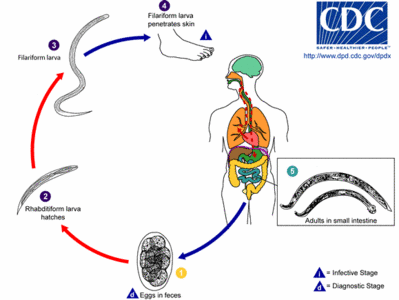Ankylostomiasis
The hookworm is a parasite that lives in the small intestine of its host, which may be a mammal such as a dog, cat, or human. Two species of hookworms commonly infect humans, Ancylostoma duodenale and Necator americanus. The distribution of each species significantly overlaps that of the other. Necator americanus predominates in The Americas, Sub-Saharan Africa, Southeast Asia, China and Indonesia, while A. duodenale predominates in the Middle East, North Africa, India and (formerly) in southern Europe. more...
Hookworms are thought to infect 800 million people worldwide. The A. braziliense and A. tubaeforme species infect cats, while A. caninum infects dogs. Uncinaria stenocephala infects both dogs and cats.
These worms are much smaller than the large roundworm, Ascaris lumbricoides, and the complications of tissue migration and mechanical obstruction so frequently observed with roundworm infestation are less frequent in hookworm infestation. The most significant risk of hookworm infection is anemia secondary to loss of iron (and protein) into the gut.
Ankylostomiasis, alternatively spelled anchylostomiasis and also called helminthiasis, "miners' anaemia", and in Germany Wurmkrankheit is the disease caused by hookworms.
It was prevalent in the mining industry in England, France, Germany, Belgium, North Queensland and elsewhere. It was known in Egypt even in very ancient times.
It caused a great mortality among blacks in the West Indies towards the end of the 18th century; and through descriptions sent from Brazil and various other tropical and sub-tropical regions.
The disease was linked to nematoid worms (Ankylostoma duodenalis) from one-third to half an inch long in the intestine chiefly through the labours of Bilharz and Griesinger in Egypt (1854).
The symptoms, as first observed among blacks, were pain in the stomach, capricious appetite, pica (or dirt-eating), obstinate constipation followed by diarrhoea, palpitations, small and unsteady pulse, coldness of the skin, pallor of the skin and mucous membranes, diminution of the secretions, loss of strength and, in cases running a fatal course, dysentery, haemorrhages and dropsies.
The disease was first known in Europe among the Italian workmen employed on the St Gotthard tunnel. In contrast with most intestinal helminthiases that concentrate parasitic load in children, hookworm prevalence is often higher among adult males. In tropical areas this is associated with high prevalence of anemia among adult men.
Hookworms are leading causes of maternal and child morbidity in the developing countries of the tropics and subtropics. In susceptible children hookworms cause intellectual, cognitive and growth retardation; as well as intrauterine growth retardation, prematurity and low birth weight among newborns born to infected mothers. Hookworm infection is rarely fatal, but anemia can be significant in the heavily infected individual.
Hookworm life cycle
See the image for the biological life cycle of the hookworm.
The hookworm larva lives in infected soil. The larva penetrates the skin on contact, e.g. when walking barefoot, enters the bloodstream and is transported to the lungs. From the lungs and bronchi it transfers to the stomach and intestine by coughing up and swallowing phlegm. The larva clings to the intestinal mucous membrane and develops into an adult hookworm, drawing its nourishment from the blood-vessels of their host, and as the parasites are found in hundreds in the body after death, the disorders of digestion, the increasing anaemia and the consequent dropsies and other cachectic symptoms are easily explained. The adult releases eggs that leave the human body with the feces. The eggs hatch in soil and eventually develop into larva.
Read more at Wikipedia.org




